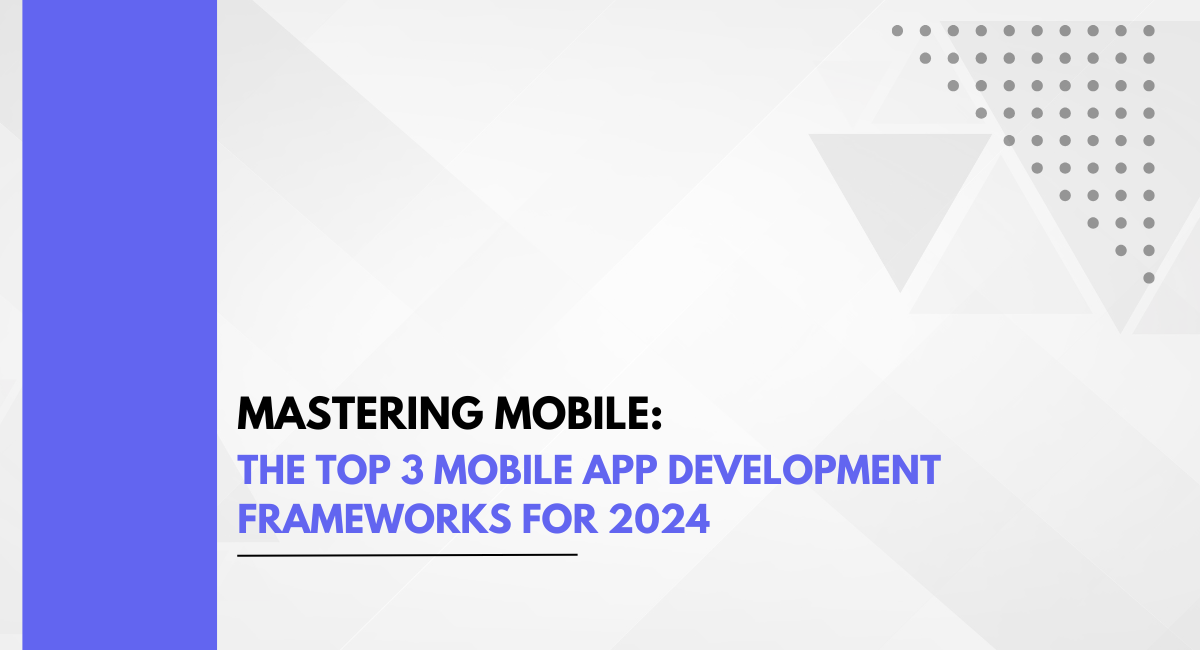In the dynamic landscape of mobile app development, selecting the right framework is crucial for crafting high-performance, visually stunning applications. As we delve into 2024, three leading frameworks—Flutter, React Native, and Xamarin—emerge as contenders to revolutionize how we build and experience mobile apps.
Growth of Cross-Platform Development
Cross-platform development has become a staple in the industry due to its efficiency and scalability. This approach allows developers to deploy apps on multiple platforms using a single codebase, saving time and resources while reaching a broader audience.
Each of the three frameworks mentioned—React Native, Flutter, and Xamarin—excels in its own right, catering to diverse needs and skill sets.
1. React Native
Developed by Facebook, React Native is one of the most widely used cross-platform frameworks. It leverages the React library to build native mobile applications for both iOS and Android. The framework's ease of use, extensive community support, and seamless integration with JavaScript libraries make it particularly appealing to developers.
One of React Native's key advantages is its ability to create robust and highly performant applications. The framework's component-based architecture allows developers to reuse code across different platforms, significantly reducing development time. Additionally, React Native has excellent tooling support with tools like Redux for state management and ESLint for code quality.
Companies like Instagram and Facebook use React Native for their mobile applications. The framework's flexibility also extends to its integration with third-party libraries, making it an ideal choice for complex, data-driven applications.
Key Features of React Native:
- Ease of Use: Simplifies mobile app development with JavaScript.
- Component-Based Architecture: Allows code reuse across platforms.
- Extensive Community Support: Backed by a vibrant and engaged community.
- Integration with Third-Party Libraries: Enhances flexibility for complex applications.
2. Flutter
Flutter, developed by Google, is another powerful cross-platform framework gaining traction in the industry. It uses the Dart programming language to create natively compiled applications for mobile, web, and desktop. Flutter's hot reload feature allows developers to see changes in real-time without rebuilding the app.
Flutter's Material Design components make it particularly appealing for developers familiar with the Google ecosystem. The framework's open-source nature and active community contribute to its rapid growth. Moreover, Flutter's performance is comparable to native apps due to its use of Skia graphics engine and 2D rendering capabilities.
Companies like Taylor Swift’s fan app and Google’s own AdMob have adopted Flutter for their mobile applications. Its ease of learning and high-performance capabilities make it an attractive option for developers looking to build visually appealing apps.
Key Features of Flutter:
- Hot Reload: Allows real-time iteration and debugging.
- Material Design Components: Integrates seamlessly with Google’s design system.
- Open-Source Ecosystem: Supported by an active and growing community.
- High-Performance UI: Uses Skia graphics engine for native-like performance.
3. Xamarin
Xamarin, developed by Microsoft, uses C# and XAML to build cross-platform applications for iOS, Android, and Windows. It leverages the .NET framework, allowing developers to share code between different platforms, thereby reducing development time and improving maintainability.
Xamarin Forms provides a set of APIs that help in creating UI components once and using them across various platforms. The framework also supports native plugins, allowing developers to extend the functionality of their apps using native modules.
For instance, companies like Uber and LinkedIn use Xamarin for their mobile applications. The framework’s strong typing system and comprehensive tooling support make it a reliable choice for large-scale enterprise applications.
Key Features of Xamarin:
- Code Reusability: Compiles C# code into native binaries for each platform.
- Native Integration: Supports native plugins for enhanced functionality.
- Comprehensive Tooling Support: Seamless integration with Visual Studio.
- Performance Optimized: Ensures optimal performance through native compilation.
Mobile App Development Frameworks
In addition to choosing the right framework, ensuring quality through rigorous testing is crucial. A robust mobile app testing framework is essential for identifying bugs early in the development cycle, thereby saving time and resources.
Some key features of an effective mobile app testing framework include:
- Automated Testing: Tools like Appium and Espresso allow for automated testing across different platforms.
- Performance Testing: Tools like Tsunami and JMeter help in evaluating the performance of the app under various loads.
- Compatibility Testing: Ensuring that the app works seamlessly across different devices and OS versions is crucial.
Choosing the right framework and integrating a comprehensive testing strategy are essential steps in building high-quality mobile applications. React Native, Flutter, and Xamarin each offer unique advantages that cater to different needs of developers—whether it’s ease of use, performance, or integration with existing toolsets.
As technology continues to evolve at a rapid pace, staying ahead of the curve requires continuous learning and adaptation. By mastering these frameworks and leveraging advanced testing methodologies, developers can create applications that not only meet but exceed user expectations.
In today’s competitive market where user experience is paramount, selecting the right tools for the job is more critical than ever. Whether you're building a simple utility app or a complex enterprise solution, understanding the strengths of each framework will guide you toward developing apps that truly excel.
You may also be interested in: Mobile Version of a Website on Chrome: A Best Guide
Book a Demo and experience ContextQA testing tool in action with a complimentary, no-obligation session tailored to your business needs.
We make it easy to get started with ContextQA tool: Start Free Trial.
